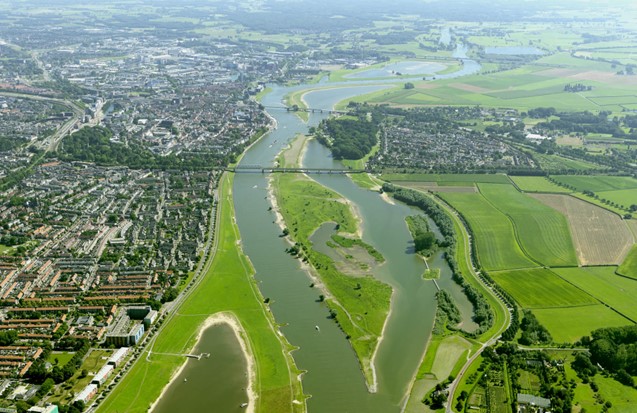Interventions and Nature-based Solutions in rivers
THE PROBLEM
There are only so many pristine, free flowing rivers left in the world. Most rivers have been altered by humans through straightening, shortening, widening, and dam installations for flood control and hydropower purposes. These rivers are generally called “engineered rivers”. Examples of such systems include the Rhine River from Basel, Switzerland to its sink in the North Sea, the Mississippi, the Danube, the Thames, the Nile, and the Murray Darling; and to a lesser extent the Jamuna and the Bramaputra in Bangladesh, and the Karnali and the Ganges in India. As early as the 1800’s, the engineering works in the Rhine basin began both in Germany and in the Netherlands, and, as a result, the river has evolved to its current state through massive bed incision of the main channel, disconnection of the floodplain and main channel, and coarsening of its bed surface texture. Additionally, due to the development of a continuous system of embankments along the river, flood risk has increased because the polders outside the protection of the dikes are low lying. While the availability of data from engineered river systems around the world, and thus an understanding of their long-term response to human modification, is highly variable, the challenges of river system engineering are, more often than not, ubiquitous. Rising sea levels and increasing frequency of extreme events driven by the changing climate pose major challenge to river system managers, who seek to ensure the habitability and utility of engineered river systems into the future. Nature-based solutions in river engineering seek to ensure access to fresh water, channel navigability, and protection of river-adjacent communities from flooding, while simultaneously supporting a biodiverse ecosystem. The overarching objective of such interventions is create more robust, climate-proof river systems that support the needs and interests of a wide variety of stakeholders.
WHAT WE DO
Our Interventions and Nature-based Solutions in River Engineering Lab in the Department of Hydraulic Engineering is looking at engineered rivers and studying interventions that counteract the problems related to channel bed incision and floodplain disconnectivity. In the Netherlands, the Room for the River program is an excellent example of how interventions in the Dutch part of the Rhine have changed the river in a positive way. This project has increased the discharge capacity of the river channel at over 35 locations, thus decreasing flood risk, improving floodplain connectivity, and improving the “spatial quality” of the river system, i.e. creating a more attractive and biodiverse river landscape with ample possibilities for recreation and enjoyment of the river. This effort involved multiple interventions across a variety of scales, including floodplain excavations and the construction of side channels, bypasses, and longitudinal dams. The design and implementation of interventions is a complex process that must consider the hydraulics and morphology of the river channel, as well as balance the cost and benefits of the various desired functions of system. Our lab groups works to improve the design of future engineering intervention through the study of their past consequences on the hydraulics, morphology, and ecology of river systems. To do this, we increasingly pursue Nature-based Solutions (NbS) – those being practices that seek to protect, sustainably manage, and restore natural and modified ecosystems in order to address societal challenges to the benefit of both humans and the environment. In short: NbS seek to provide solutions to engineering problems while simultaneously providing co-benefits to a wider range of stakeholders. There are, however, many questions of how to implement NbS in practice, such as:
• When does an intervention get the stamp of “NbS”, and what exactly should that mean?
• How do we design, construct, and maintain a NbS?
• What will it take for NbS to be considered a standard approach to river restoration?
These are the sort of questions that we address with in our lab, as well as in national, European, and other international projects.
CURIOUS TO KNOW MORE ABOUT INTERVENTIONS AND NATURE BASED SOLUTIONS IN RIVER ENGINEERING?
Understanding the behaviour of interventions means understanding the river. Interventions are neither entirely grey or green solutions, rather, they typically have a hybrid character. The concept of Nature-based solutions brings in new challenges and provides new solutions. There is a need for frameworks, best practices, and guidelines, but also an understanding of how to quantify the co-benefits of NbS and provide scientific, practical, and societal evidence that they work. This (practical and theoretical) research is carried out by BSc students, MSc students, PhD students, and postdocs.
ONGOING PROJECTS
The types of projects vary from theory-driven to application-driven, examples are as follows:
- ResiRiver: Creating Resilient River Systems by Mainstreaming and Upscaling NbS , an INTERREG North West Europe project. See resiriver.nweurope.eu . Contact Ralph Schielen
- The International Guidelines on Natural and Nature Based Features. See ewn.erdc.dren.mil/international-guidelines-on-natural-and-nature-based-features-for-flood-risk-management/. Contact Ralph Schielen
- MSc thesis Tatiana Andrikoupoulou and Maikel Berg.
MAIN CONTACTS


